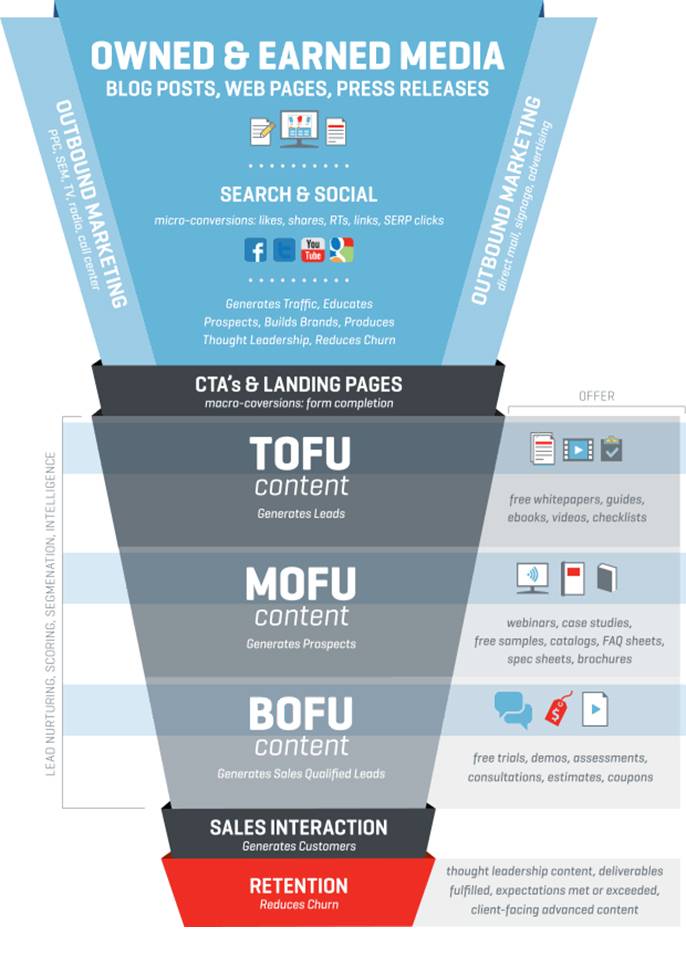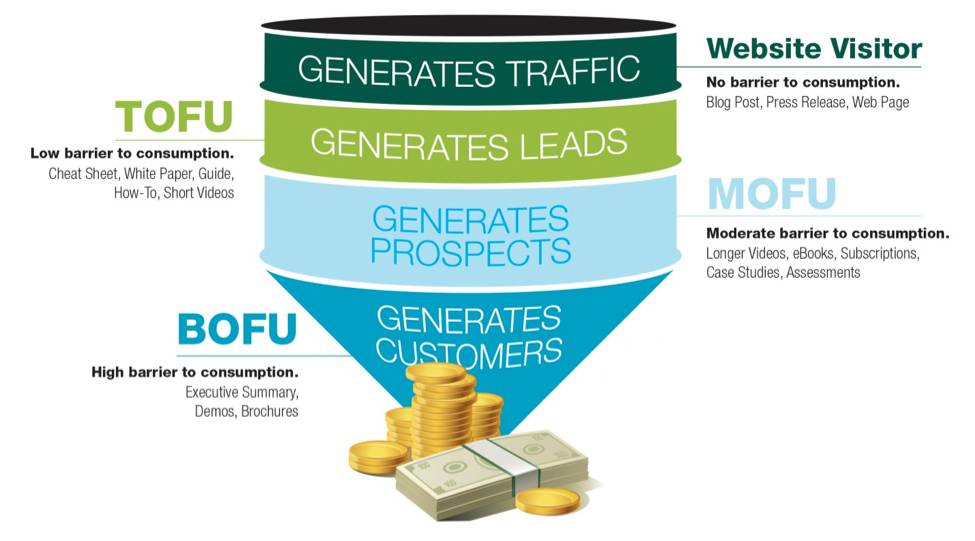No matter what business you are in, if you have a website or are running a marketing campaign that you want to convert into sales, having a sales funnel is paramount.
Sales funnels are basically a way that you can ensure your promotions and marketing tools are working effectively and efficiently to deliver the results that you desire.
Without having a funnel to capture your users and build customers, you could be wasting hundreds of thousands of dollars, time, energy, resources are more.
So, where do you begin? How do you start creating a sales funnel?
First, understand what the intention of your sales funnel is. What exactly are you trying to achieve? What is your ultimate goal?
Here is a simple and basic understanding of what a typical sales funnel would look like for most business-
As you can see, the strategy is to attract leads, offer them some type of free product or service and then pitch them a low cost item with the hope that they will up-sell to a higher cost item in the future.
This particular model may not work for you business. If this is the case, work out what your ultimate goal is and then work backwards from there.
Once you have your framework in place, the next step would be to break down each stage of the funnel to determine how you are going to get them to move from point A to point B.
This is a crucial step- you may have the best and most logical sales funnel in place, but if you don’t calculate how they are going to move from one point to another, you may find that your funnel never converts.
Most funnels will start with the same step: attracting leads. This is not as easy as it sounds and could cost your company a lot if you don’t know what you are doing.
Here are some suggestions on how to attract leads:
Blog Entries
This is a common way to attract leads as it helps to build the voice of your company and allows your potential customers to rely and trust in you. It also helps them to understand what services you offer and whether they resonate with your style and cause.
Building a blog that is entertaining and gets traffic takes a lot of work but there are a few ways you can go about achieving it.
#1: Hire a content writer or copywriter with a knowledge in basic SEO to write content daily. It’s important that the content is posted regularly to help keep your page up to date and relevant for your customers. The posts should be genuine, knowledgeable and offer some type of information that relates to your product and service. Once you have built up a collection of at least 10 posts, if not more, you can start marketing them on social media platforms and on services such as Google Adwords.
#2: You can write the blogs yourself so your readers get an idea of your style, personality and voice. This would be a good strategy if you were offering a service that exclusively relied on you. For example, a coaching or consulting service. This will obviously take up a lot more of your time and energy and will be slower to build, however, it will definitely pay off in the long run. Most dedicated bloggers find that majority of their revenue and sales comes from their blog.
Run a PR Campaign
Hiring a public relations company to run a campaign about your product can be highly effective however, it could also be a huge waste of resources and detrimental to your company if you don’t have all the right tools in place. If you are going to spend the money to run a PR campaign, your site must be up to date and functioning like a well oiled machine. Your sales funnel should be rigorously tested or at least put together by a professional who knows what they are doing.
The risk with running a PR campaign before your company is truly ready is that first impressions stick, and you don’t want your customers to have the wrong idea about what you are offering.
Social Media
Many companies find success by building up a fan base on social media. While Facebook is a good platform for sharing content and ideas, think further afield to Twitter and Instagram. These two social media sites are not content heavy which means they are perfect to run in conjunction with your blog marketing. Alternatively, if you wanted to skip the blog idea altogether, they are a great way to still let the world know you exist.
On Twitter, stick to indirect marketing. This means you don’t want to bombard your twitter following with links to sales pages. Instead, you want to share a variety of content from around the web that is relevant to your product or service. For example, if you run a marketing company share content about landing pages, the latest tech gadgets etc. etc.
Then once you have built up a following, you can slowly start to introduce some of your own products and services.
The same applies for Instagram. This social platform uses just images to help engage fans. It can be highly effective for certain industries such as cosmetics, fashion, beauty, food and more. If you don’t run a company that is highly visual, in other words, you don’t have photos of items you can share, why not post quotes or other images that indirectly relate to your business? Be creative, try different strategies.
SEO
Search engine optimisation is a little bit of a dark horse in the marketing world. No one really knows how Google’s algorithm works and if they do, chances are they are going to charge a pretty penny to give you the information. There are basic SEO rules to follow, however what it really comes down to is quality content.
At the end of the day, Google and other search engines design their algorithm to be user friendly, which means if it’s relevant and good for the user, chances are it will appear high up in search results.
Hiring an SEO team is definitely recommended if you really want to ensure your results are at the top of Google. This is because SEO is one of those things that can be time consuming and can cost your business if you don’t do it right.
Search engines, like Google have many red flags that they look for and if they deem your site is trying to manipulate their algorithm, you could be blacklisted for life.
Share Content/ Guest Post
Another great way to attract leads is to share your content on other sites or offer to write for other sites. This is a great strategy if you want to build your blog fast and reach a relevant demographic. Start with a site that has a similar following or traffic reach as your own, and then build up to sites that have a higher following. You can also organise to cross promote each others content on different social media platforms.
Once you have started to generate leads, the next step is to get their details by offering some type of service or freebie that is quick and easy to access.
Think of this as a fair exchange- you want their email address and in return you have to entice them with something as well.
This is a good time to remind you of ensuring that you not only have the main steps of your sales funnel laid out, but also your detailed strategy on how they are going to move from one point to the next.
Here are a few suggestions that you can offer your readers in exchange for their email:
- Audio Recordings
- Newsletters
- E-Courses
- E-Books
- Resource Lists
- Graphics
- Teleseminars
- Free Consultation
Of course, what service you offer will heavily depend on what type of product you sell and what your next step is in your sales funnel.
Once you have hooked them in with the free product or service, you have their email address and you can now begin ramping up your marketing strategy and tactics.
The next step in the sales funnel example we are working with is offering a range of low cost items that show off your expertise or what your brand is all about.
The first product you pitch your leads does not have to be the cheapest but it does need to be the most relevant. For example if you are selling shoes, start with your base model and then work your way up to the higher end designs.
Think about what your signature product is and then start from there. This is definitely something that would need to be tested out and monitored as different demographics would respond differently.
Now that you have your signature or most relevant product to sell, how do you go about it? How do you go from an email address to a sale?
If you have integrated the first steps of your sales funnel accurately, your customers should know what you are about and what you offer, but that doesn’t mean you can’t afford to educate them a little more.
If you want your customers to purchase your product, you have to give them a need and you have to understand what needs they may of already presented to you through their involvement so far.
For example, if you have a lead that is actively engaged on Facebook, has opened many emails or has signed up to your email list, they can be viewed as a Marketing Qualified Lead (MQL), which basically means they are a potential customer.
Marketing 101 categorises MQL’s into 4 groups- it is worth understanding this in order to market to them effectively:
Low Interest, Low Fit
These are the leads that are the least likely to buy. They perhaps don’t have a need for your product and have only been loosely engaged. It doesn’t mean that you need to give up on these potential customers, but it’s worth noting that they will be generally slower to take action.
How would this change your marketing strategy? Perhaps you need to offer more information, more freebies or create more of a need.
High Interest, Low Fit
These are potential customers that are looking for a product and service that you offer but are unlikely to choose you over another product or company. There are many reasons for this and none that you should take personally. In fact, you should learn from these types of MQL’s and use it as a way to update or integrate different elements into your products and services.
Does this mean you shouldn’t market to these leads at all? At the end of the day, you must accept that not everyone is going to purchase your product however, a lead is a lead and there is no reason why you can’t keep them engaged with bonus content and other indirect sales tactics.
Low Interest, High Fit
These are leads that are your target customer but are not interested in purchasing your product. These types of leads are highly valuable but will be slow to make a sale. It is definitely in your best interest to continue to market to them and coerce them step by step through what your products and services entail. Your hard work here will definitely pay off down the road.
High Interest, High Fit
If only all leads could fall into this category! This of course is the ultimate MQL that is ready to buy and loves your product. These leads should be the highest priority of your sales team because they are going to yield the highest ROI.
Once you have determined where your leads fit, you can then begin the final step of your sales funnel and that is introducing them to the ultimate product.
In the example we have been following there has been a strong emphasis on the eventual up-sell. Again, you need to work out what will work best for your company and services but if you went with this strategy, you would have to explore how you would get your buyers to return again.
One effective way to do this would be offering one-click up-sells at the checkout page or in an email subscription.
There are endless ways to market your product, but understanding your leads needs and wants can be the key to unlocking how to move them through the sales funnel from start to close.
As you can see having a sales funnel helps you to organise your strategy into a neat step by step package. This article has merely scraped the surface of generating a highly converting sales funnel however, hopefully it has jogged some questions in your mind about how you can improve upon your conversion rate.



Hey!
It looks like you're browsing in . Would you like to switch over to the website?